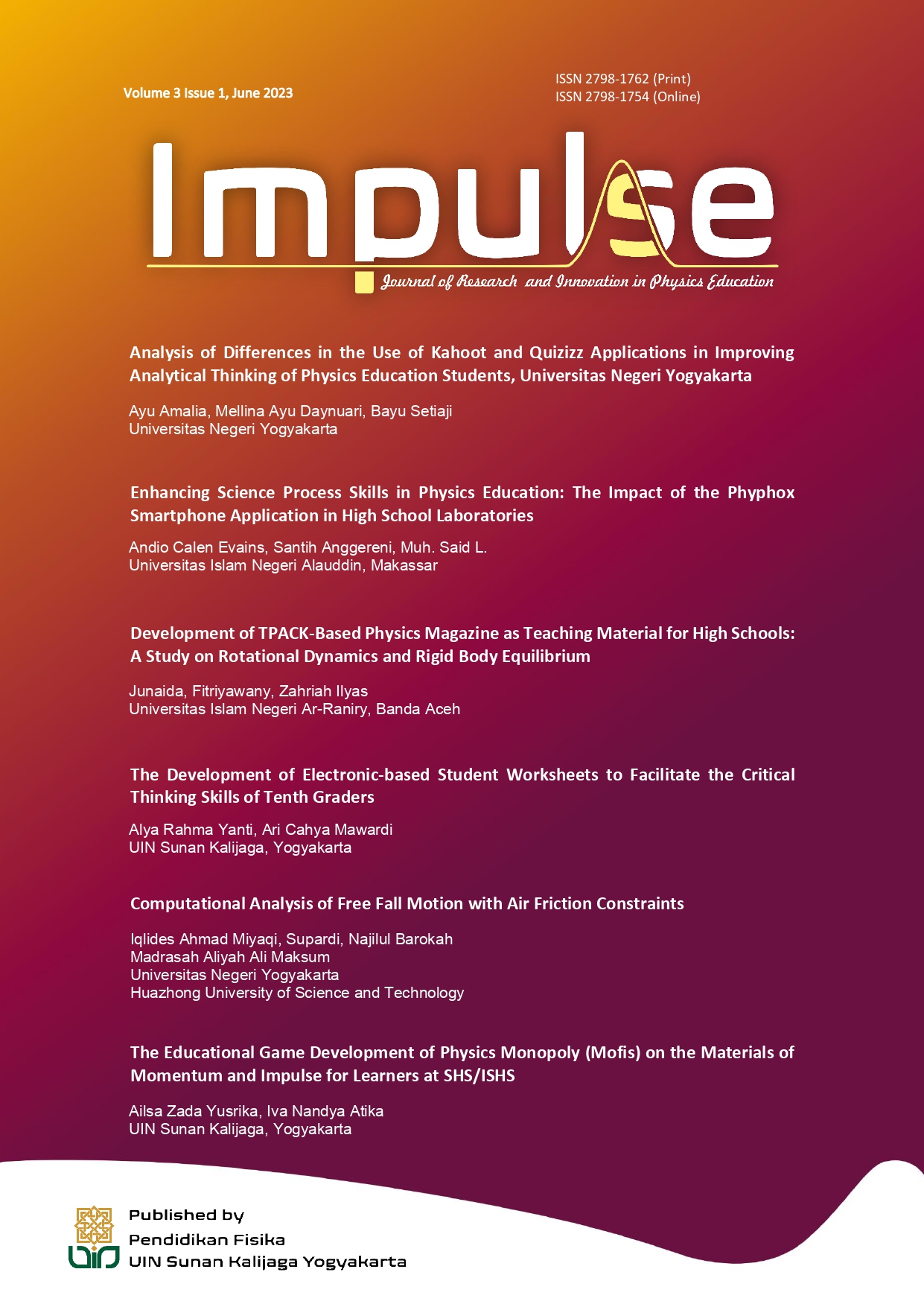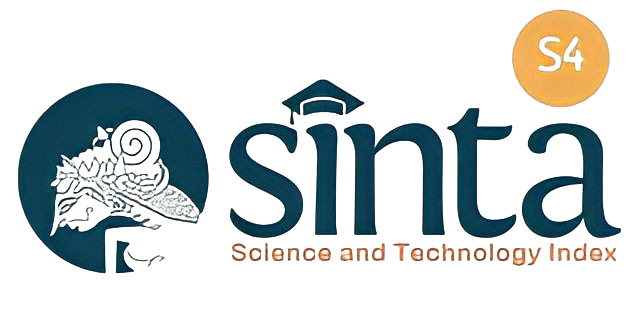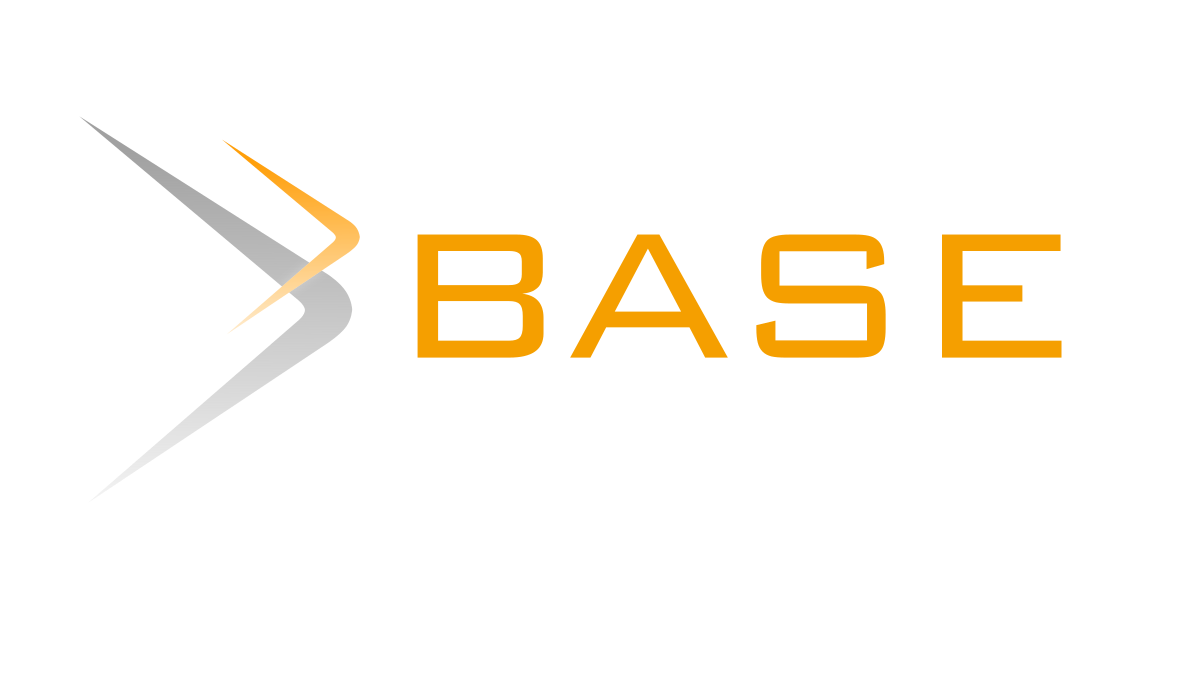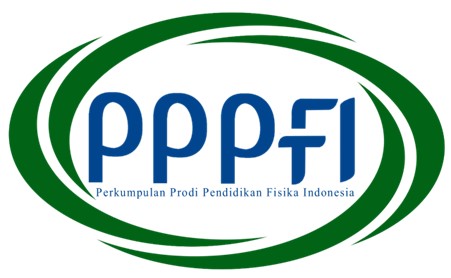Computational Analysis of Free Fall Motion with Air Friction Constraints
DOI:
https://doi.org/10.14421/impulse.2023.31-05Keywords:
free fall motion, air friction, IDE SpyderAbstract
Free fall motion without initial velocity is a mechanical concept that can be analyzed using analytical, experimental, and computational methods. Free fall motion is difficult to analyze analytically if air friction is not neglected. The aim of this research is to explain computational free fall motion analysis procedures with air friction. Air friction disturbance in free fall motion is represented by the coefficient C which states the drag coefficient is time dependent. In this scientific study, the application used for computational analysis is IDE Spyder with various library support. With the help of this application, a significant difference in the output vmax and tmax is obtained between the two cases of free fall based on the interpretation of the graph that appears.
Downloads
References
P. H. Winingsih et al., “Analysis of understanding of physics concepts through problem solving units review in free fall motion materials,” Revista Mexicana de Física E, vol. 20, no. 2 Jul-Dec, pp. 020205 1-6-020205 1–6, Jun. 2023, doi: 10.31349/REVMEXFISE.20.020205.
Muhammad Subhan, Eka Rahmawati, Lis Suswati, Y. Yus’iran, and F. Fatimah, “Variasi Ketinggian MDPL terhadap Nilai Percepatan Gravitasi Bumi pada Konsep Gerak Jatuh Bebas (GJB) untuk Pendekatan Pembelajaran,” Jurnal Pendidikan MIPA, vol. 12, no. 3, pp. 831–837, Sep. 2022, doi: 10.37630/jpm.v12i3.660.
D. C. Giancoli, Physics for Scientists & Engineers, Vol. 1 (Chs 1-20). Pearson Education UK, 2013.
N. Mambai, Triwiyono, and A. Lumbu, “Implementation of an Inquiry Model Assisted with PHET and Teaching Aids to Improve Vocational Students’ Learning Outcomes in The Sound Waves Concept,” Impulse: Journal of Research and Innovation in Physics Education, vol. 2, no. 2, pp. 97–106, Dec. 2022, doi: 10.14421/impulse.2022.22.04.
M. S. Zulkarnain and J. Sabaryati, “Solusi Numerik Logika Fisika Berbasis Matlab Algoritm,” Ahlimedia Book, Medan, 2008.
F. M. Bara, “Analisis Percepatan Gravitasi Menggunakan Aplikasi Phyphox Pada Gerak Jatuh Bebas,” Jurnal Luminous: Riset Ilmiah Pendidikan Fisika, vol. 2, no. 2, pp. 11–17, 2021.
A. Ghisi, D. Faraci, S. Adorno, and A. Corigliano, “The role of anchor imposed motion in the failure of MEMS microphones under free fall tests,” Microelectronics Reliability, vol. 135, 2022, doi: 10.1016/j.microrel.2022.114584.
T. Firdaus, E. Erwin, and R. Rosmiati, “Eksperimen Mandiri Siswa dalam Penentuan Percepatan Gravitasi Bumi pada Materi Gerak Jatuh Bebas,” Titian Ilmu: Jurnal Ilmiah Multi Sciences, vol. 11, no. 1, pp. 31–36, 2019.
J.-T. Kim, Y. Jin, S. Shen, A. Dash, and L. P. Chamorro, “Free fall of homogeneous and heterogeneous cones,” Phys Rev Fluids, vol. 5, no. 9, 2020, doi: 10.1103/PhysRevFluids.5.093801.
W. E. Ardhanariswari, W. N. Wulandari, H. I. Khalidah, and B. Setiaji, “Analysis of High School Students’ Learning Difficulties in Understanding the Mechanics Concept,” Impulse: Journal of Research and Innovation in Physics Education, vol. 1, no. 2, pp. 72–79, 2021.
A. Pujianto, “Analisis konsepsi siswa pada konsep kinematika gerak lurus,” JPFT (Jurnal Pendidikan Fisika Tadulako Online), vol. 1, no. 1, pp. 16–21, 2013.
M. Tawil and M. Amin Said, “Understanding the Newton’sMotion Concept Through Qualitative and Quantitative Teaching,” JPPPF, vol. 8, no. 1, 2022, doi: 10.21009/1.
D. Halliday, R. Resnick, and J. Walker, Fundamentals of Physics. John Wiley & Sons, 2013.
J. Miljojković, V. Kočović, M. Luković, A. Živković, and K. Šimunović, “Development of a Modular Didactic Laboratory Set for the Experimental Study of Friction,” Tehnicki Vjesnik, vol. 29, no. 1, pp. 269–277, 2022, doi: 10.17559/TV-20210925171045.
F. Lyrath, C. Stechert, and S. I. U. Ahmed, “Application of Augmented Reality (AR) in the Laboratory for Experimental Physics,” Procedia CIRP, vol. 119, pp. 170–175, Jan. 2023, doi: 10.1016/J.PROCIR.2023.03.089.
R. Ekawati, A. Setiawan, A. R. Wulan, and D. Rusdiana, “Development of concept essential in kinematic topics,” in Journal of Physics: Conference Series, 2020. doi: 10.1088/1742-6596/1521/2/022019.
N. Yuningsih and S. Sardjito, “Gerak Vertikal Benda Berukuran Berbeda yang Jatuh Tanpa Kecepatan Awal dan Bergesekan dengan Udara,” in Prosiding Industrial Research Workshop and National Seminar, 2020, pp. 710–714.
S. Achouch, L. Masmoudi, M. Gharbi, and P. Nonnon, “Design and development of a sensor for distance and velocity measurement using an Infrared camera for studying kinematic movements,” in 2019 International Conference on Wireless Technologies, Embedded and Intelligent Systems, WITS 2019, 2019. doi: 10.1109/WITS.2019.8723696.
E. Pardiyanto and W. Winarti, “Generative Learning Strategy Assisted by Flash Animation to Remediate Students’ Misconceptions on Newton’s Law of Gravity,” Jurnal Pendidikan Sains Indonesia (Indonesian Journal of Science Education), vol. 9, no. 2, pp. 201–216, 2021.
P. Winingsih et al., “Analysis of understanding of physics concepts through problem solving units review in free fall motion materials,” Revista Mexicana de Física E, vol. 20, no. 2 Jul-Dec, Jun. 2023, doi: 10.31349/RevMexFisE.20.020205.
N. Yuningsih, S. Sardjito, and Y. C. Dewi, “Determination of earth’s gravitational acceleration and moment of inertia of rigid body using physical pendulum experiments,” in IOP Conference Series: Materials Science and Engineering, IOP Publishing, 2020, p. 022001.
N. S. Belousova and O. G. Glotov, “Laws of motion and aerodynamic drag coefficient for large titanium particles burning in air,” Thermophysics and Aeromechanics, vol. 29, no. 4, pp. 557–565, 2022, doi: 10.1134/S0869864322040084.
P. Mohazzabi, “When does air resistance become significant in free fall?,” Phys Teach, vol. 49, no. 2, pp. 89–90, 2011.
M. Garg, K. Kalimullah, P. Arun, and F. M. S. Lima, “Accurate measurement of the position and velocity of a falling object,” Am J Phys, vol. 75, no. 3, pp. 254–258, 2007.
G. Avallone, L. Agostini, M. Conconi, V. Parenti-Castelli, R. Vertechy, and N. Sancisi, Low-Cost Gyroscope and Accelerometer Calibration with Free Fall Pendulum Motion: Results and Sensitivity, vol. 606. 2022. doi: 10.1007/978-3-031-06409-8_15.
H. Putranta et al., “Visualization of Refractive Index and Reflectance of Sodium Metal Based on Drude’s Theory Using MATLAB as an Alternative for Optics and Astrophysics Lectures.,” SAR Journal (2619-9955), vol. 5, no. 3, 2022.
A. Seto Priambodo and A. Sony, “Studi Komparasi Simulasi Sistem Kendali PID pada MATLAB, GNU Octave, Scilab, dan Spyder,” ELINVO, vol. 4, no. 2, pp. 169–175, 2019, doi: 10.21831/elinvo.v4i2.
B. Crnokić, F. Pehar, J. Spajić, and I. Bagarić, “Stem classroom: Creating a phyton application for an EV3 brick robotic system used to transport 3D printed boxes,” in Annals of DAAAM and Proceedings of the International DAAAM Symposium, 2020, pp. 88–97. doi: 10.2507/31st.daaam.proceedings.012.
E. Bufasi and K. Lakrad, “Improving Teaching Techniques Using Visual Python: A Case Study,” 2019. [Online]. Available: www.ijstr.org
E. Muzayyanah, A. Megananda, H. P. Darmayanti, and Z. I. Priana, “Development of digital distance measurement instrument based on Arduino Uno for physics practicum,” Impulse: Journal of Research and Innovation in Physics Education, vol. 1, no. 2, pp. 80–88, 2021.
A. Jodra, C. García-Iriepa, and L. M. Frutos, “An Algorithm Predicting the Optimal Mechanical Response of Electronic Energy Difference,” J Chem Theory Comput, vol. 19, no. 18, pp. 6392–6401, 2023, doi: 10.1021/acs.jctc.3c00490.
M. Serik, G. Yerlanova, Y. N. Karelkhan, and N. Temirbekov, “The Use of The High-Performance Computing in The Learning Process,” International Journal of Emerging Technologies in Learning, vol. 16, no. 17, pp. 240–254, 2021, doi: 10.3991/ijet.v16i17.22889.
A. Astalini, D. Darmaji, D. A. Kurniawan, and N. N. Simamora, “Comparison of Perception and Implementation of Mathematical Physics for Matrices,” Jurnal Pendidikan Fisika dan Keilmuan (JPFK), vol. 7, no. 1, Jul. 2021, doi: 10.25273/jpfk.v7i1.9509.
H. W. Prabawa, R. Rosjanuardi, and E. Nurlaelah, “Problem Decomposition Skills, Mathematical Maturity, and Their Relation to Mathematics Problem-Solving in A Computer Science Learning Class,” Jurnal Kependidikan: Jurnal Hasil Penelitian dan Kajian Kepustakaan di Bidang Pendidikan, Pengajaran dan Pembelajaran, vol. 9, no. 3, p. 946, Sep. 2023, doi: 10.33394/jk.v9i3.8258.
A. Susac, A. Bubic, E. Kazotti, M. Planinic, and M. Palmovic, “Student understanding of graph slope and area under a graph: A comparison of physics and nonphysics students,” Phys Rev Phys Educ Res, vol. 14, no. 2, 2018, doi: 10.1103/PhysRevPhysEducRes.14.020109.
P. A. Tipler and G. P. Mosca, Physics for Scientists and Engineers, 5th edition - Volume 1, vol. 1. 2002. Accessed: Jun. 04, 2023. [Online]. Available: https://ui.adsabs.harvard.edu/abs/2002pse..book.....T/abstract
L. K. Wee, K. K. Tan, T. K. Leong, and C. Tan, “Using Tracker to understand ‘toss up’ and free fall motion: A case study,” Phys Educ, vol. 50, no. 4, pp. 436–442, 2015, doi: 10.1088/0031-9120/50/4/436.
M. Garg, K. Kalimullah, P. Arun, and F. M. S. Lima, “Accurate measurement of the position and velocity of a falling object,” Am J Phys, vol. 75, no. 3, pp. 254–258, 2007.
N. Yuningsih and S. Sardjito, “Experimental study of determination of earth’s gravitational acceleration using the concept of free-fall motion and conservation of mechanical energy,” in AIP Conference Proceedings, AIP Publishing, 2021.
A. Mayang Sari, “The Integrated Physics Learning E-Module with Pancasila Character Values in Work and Energy Subjects as Solution to Improve Students’ Critical Thinking Ability and Independence: Is It Effective?,” Jurnal Ilmiah Pendidikan Fisika Al-BiRuNi, vol. 10, pp. 85–100, 2021, [Online]. Available: https://ejournal.radenintan.ac.id/index.php/al-biruni/index
M. S. da Silva, L. A. Heidemann, and R. R. Campomanes, “Combining computational and experimental activities: an alternative using the free fall paradox | Integração de atividades computacionais e experimentais: uma alternativa utilizando o paradoxo da queda livre,” Revista Brasileira de Ensino de Fisica, vol. 45, 2023, doi: 10.1590/1806-9126-RBEF-2023-0082.
J.-L. Gao, W.-J. Bi, J. Zhang, and J. Zang, “Numerical Investigations on Harbor Oscillations Induced by Falling Objects,” China Ocean Engineering, vol. 37, no. 3, pp. 458–470, 2023, doi: 10.1007/s13344-023-0038-y.
G. Kalies and D. D. Do, “Momentum work and the energetic foundations of physics. I. Newton’s laws of motion tailored to processes,” AIP Adv, vol. 13, no. 6, 2023, doi: 10.1063/5.0147910.
Downloads
Published
How to Cite
Issue
Section
License
Copyright (c) 2023 Impulse: Journal of Research and Innovation in Physics Education

This work is licensed under a Creative Commons Attribution-NonCommercial 4.0 International License.


























